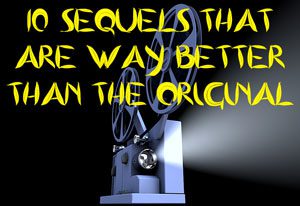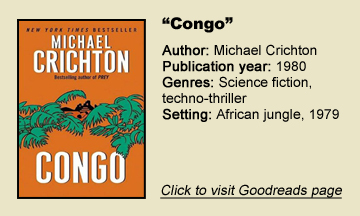In “The Andromeda Strain,” Michael Crichton detailed nature’s microscopic but serious threat to mankind, and in “Congo” (1980) – his best novel up to this point – he illustrates nature’s worldwide threat to mankind. It’s a sneaky man-versus-nature novel, seemingly less focused than his other techno-thrillers but still achieving a powerful theme about how nature dwarfs us and will bury us in the end as it has all previous fossils and architectural ruins.
Past meets future
Narratively, “Congo” follows a 1979 African expedition that boasts high-tech camping, defense and communications gear while also tapping into the spirit of 19th century expeditions, because Africa is still so vast and mysterious. The author makes that famous point about how flat maps (which scrunch the equatorial regions and expand as you go toward the poles) make us underestimate how huge the continent is.
He notes that the jungle only covers a small portion of Africa, yet even the jungle is massive, with many micro-environments where uncatalogued flora are found — and even uncatalogued fauna, something that becomes “Congo’s” tense mystery thread.
Character-wise, we get Crichton’s most pop-off-the-page personality up to this point: Amy, the 7-year-old sign-language-using gorilla.
The human leads, meanwhile, each have one core trait. Peter Elliot (most often the POV character) is Amy’s caretaker, Karen Ross is a driven young field scientist, and Munro is a rugged guide with a softer side.
I like how Munro quickly takes to Amy, often indulging her requests to be tickled. Africans serve as porters on the trek and also as Red Shirts, to borrow the “Star Trek” term for the undeveloped characters who are most likely to be killed.
Stumbling into classic status
“Congo” has the feel of stumbling into classic status. Crichton repeats his “Andromeda Strain” method of giving us a little bit of story, then a little bit of researched, real-world context. Those pauses in the story are worth it, because the story gets enriched. Compare this to his much weaker John Lange novel “Easy Go,” also about an African adventure (albeit in the Egyptian desert). There, Crichton eschews deep dives into history and science, and the book is lacking.
“Congo” doesn’t have a consistent focus (it’s about many different things simultaneously), yet that somehow doesn’t hurt the novel much; it feels layered and rich.
The point of the mission – for ERTS (Earth Resource Technology Services), for which Ross works – is to find blue diamonds near the Lost City of Zinj in the Congo (then known as Zaire, and now called Democratic Republic of the Congo). It’s sort of an excuse to get this action moving into the “King Solomon’s Mines”-style yarn – and indeed, Peter’s and Amy’s involvement is forced to a degree that made me smirk.
An informative adventure
But the adventure for the characters doubles as an information feast for the reader. Crichton writes that the blue diamonds will mark the next sea change in miniaturization of technology.

As a reader, I fall into a sweet spot wherein I know little enough about details of the technology, and Crichton explains those details so well, that this feels as fresh to me as to a 1980 reader. The tech might be outdated, it might be pure sci-fi BS (although I doubt it), and my ignorance serves me well.
The author’s tangents are nonetheless still broadly relevant, and fascinating. He pontificates about how future wars will be fought by machines, which wasn’t a new SF concept even then, but his discussion of the sheer speed of those wars is enlightening.
Gorilla science
The best science tidbits, though, are about gorillas. I was fascinated to learn that gorillas view past and future in the opposite fashion of humans. We metaphorically see the future as being ahead of us and the past behind us. Gorillas see the past as being a known quantity and the future unknown. When Amy is expecting a visitor, she looks behind her, where she can’t see.
Crichton digs further into the notion of human bias, citing another scholar’s argument that perhaps apes are smarter than humans. Many gorillas and chimpanzees have lived in human society and communicated in our language, but far fewer humans have integrated with gorilla or chimp culture or learned their languages on their terms.
Of course, that argument can be rejected in many ways, but it does highlight humans’ ingrained bias when measuring intelligence. Sure, living in cities with high technology is an advancement over hunting-and-gathering cavemen, and indeed, we have quality-of-life metrics that delineate the First World and the Third World.
But on the other hand, maybe gorillas are happy in the jungle; maybe it’s human bias to say they’ve comparatively “failed.” The “Planet of the Apes” saga – which had wrapped up its original timeline slightly before Crichton’s book — might be the place to go to delve further into these notions.
Amy steals the show
“Congo” arguably trips up a little as an emotional, personal piece and draws a target as an example of Crichton not being a character writer.
As noted, the gorilla is the most vibrant “person.” I fell in love with Amy over the course of this book. Her simple yet understandable italicized sign language sentences (Amy like Peter; Peter tickle Amy) are endearing. In a way, it’s appropriate that the resolution to Amy’s story happens in a footnote. But for a more emotionally robust story of a primate living with a human family, check out Douglas Preston’s “Jennie.”
Elliot, Ross and Munro – to say nothing of the poor porters — don’t leave as much of an impression, and I can see how a screenwriter wanting to turn this into a movie would have to write arcs, because they are almost nonexistent in the book. Then again, people’s minimal impact on the untamed part of nature – even as nature effortlessly ruins their day — is also the very point of Crichton’s “Congo.”


